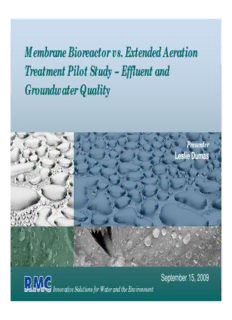
Membrane Bioreactor vs. Extended Aeration Treatment Pilot Study PDF
Preview Membrane Bioreactor vs. Extended Aeration Treatment Pilot Study
Membrane Bioreactor vs. Extended Aeration Treatment Pilot Study – Effluent and Groundwater Quality Presenter Leslie Dumas September 15, 2009 Innovative Solutions for Water and the Environment Acknowledgements Thanks to: Colin Moy, REA., East Bay Municipal Utility District [EBMUD] – Project Manager Eileen Fanelli, P.G., East Bay Municipal Utility District/Presidio Trust – Project Manager David W. Smith, Ph.D., Merritt Smith Consulting – Principal Investigator Background • WateReuse Foundation Project WRF-04-016 • Project Title: Development of Regulatory Protocol for Incidental Environmental Reuse of Title 22 Recycled Water Issued August 2005 to EBMUD with RMC Water & Environment EBMUD’s ‘upcountry’ wastewater systems needs: Upgrading systems to meet evolving regulatory requirements • Beneficial reuse of treated effluent • Use of small MBR treatment systems • The Pardee Site Key Challenges to Recycling in California • Regulatory Compliance - Resolution #68-16 Antidegradation Policy • Cost-Benefit for Small Systems Higher capital cost to implement MBR treatment Little to no reduction in longer-term operating costs Permitting costs increase overall capital costs Study Goals • Recognize baseline assumptions on meeting CCR Title 22 standards for unrestricted use • Provide a standardized process (Framework) for evaluating recycled water projects • Utilize established and industry-accepted tools and practices for assessment A Two-Part Study Approach was Used • Develop a Framework (standardized process) • Conduct a Pilot Test Pilot Study Design • Conducted over 12 month period • Sampled and analyze influent, effluent and groundwater quality from both existing and pilot systems • Apply data to Framework analysis • Identify key operating differences between the extended aeration and MBR treatment plants Treatment Trains PACT Extended Aeration Plant Schematic Pilot MBR Plant Schematic Conventional Plant
Description: